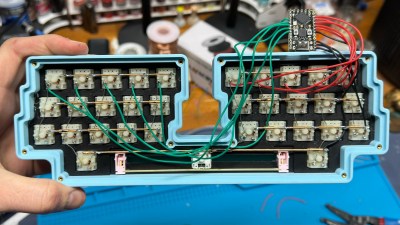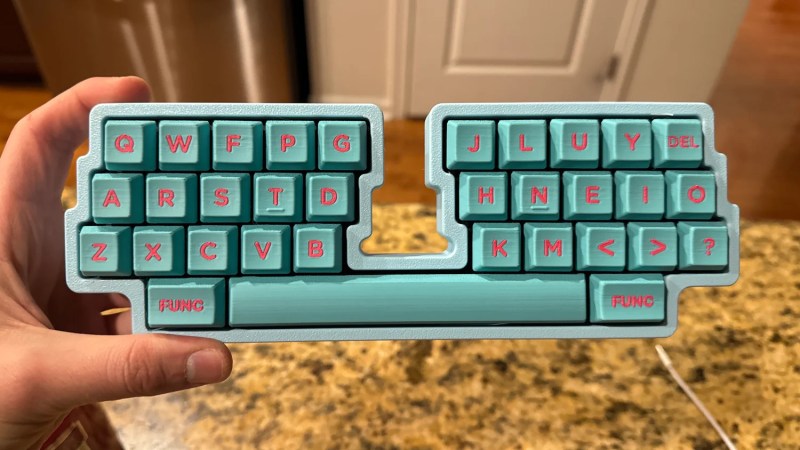The lovely thing about a hobby like keyboard building is that the melting pot of designs manages to never turn into a nasty porridge. Rather, it remains a tasty chili that keeps getting more flavorful with time. It’s a simple recipe, really; someone becomes dissatisfied enough with their peripherals to do something about it, often trying various designs until they either settle on one, or come up with yet another awesome variant that suits their needs — and possibly someone else’s down the line.
 The inimitable [Joe Scotto] has happened upon the katana layout, which has an inverse left-hand row stagger that lends symmetry to the design, and Scotto-ized it into a 33-key build that he says is the best-sounding one yet with lubed Gateron Milky Yellows.
The inimitable [Joe Scotto] has happened upon the katana layout, which has an inverse left-hand row stagger that lends symmetry to the design, and Scotto-ized it into a 33-key build that he says is the best-sounding one yet with lubed Gateron Milky Yellows.
The case and the keycaps are both 3D-printed, and as with all Scotto builds, it is beautifully hand-wired. This one uses an RP2040 Pro Micro, but an ATMega Pro Micro will work, too.
Everything is available on GitHub, and [Joe] promises a typing test soon, as well as a gasket version that foregoes the integrated plate.
Do you need a fast keyboard? Like, ridiculously fast? Then you should use an FPGA.















In terms of keyboard layouts – it’s interesting to watch people argue about QWERTY vs. DVORAK with arguments like having the most vowels in the home row, without accounting for the fact that people’s fingers don’t naturally lay along a line but an arc that spans two rows.
How much of keyboard ergonomics is just cargo cult science?
Mavis Beacon indoctrinated me to QWERTY very early on and now I can’t imagine using anything else
The QWERTY+ are not folks you want to mess with.
OH man do I have good news and bad news for you!
Good news: very little (if any) good, controlled testing to date has shown that DVORAK or other arrangements of the letters confers any real advantage. Hence, the discussion remains a practical stalemate.
Bad news: You discussion about fingers in an arc is ‘outside of scope’ for the QWERTY vs DVORAK debate: nobody has talked about it because neither format does anything about it, and if you did do anything about it then you have to retrain muscle memory and it gets annoying to type on 99.99% of keyboards.
Good news: There are people who talk about the curve of the fingers. You need to see the /other/ nerd fight about whether “staggered” or “ortholinear” layouts are better. A subcategory of ortholinear puts the keys in little arcs to line up with fingers and the curve they are in.
You may wonder: “Dude, are you one of those keyboard weirdos?”
Yes. I’m typing this response on a split ortholinear keyboard remapped for DVORAK. I bought a 2nd one for the office. Few people get this deep without having done a ton of reading up on these things.
I find the statistical argument convincing (and my keyboard does a live heatmap as I type, so I can confirm the nexus of activity where it is expected), but being the insufferable empiricist that I am I won’t pretend that one or another setup is better for you. I’ll just tell you that I like mine!
Euhm, Colemak needs a mention here…
On top of its other benefits, it’s also optimised for bigrams (e.g.- th-, -ng-, …), thus it just flows better than Dvorak.
Is alternating on a bigram optimized? Seems very hard to beat dvorak’s middle-index same hand placement for -th-, but maybe you just picked a pour example without knowing?
Well, I can throw an extra spanner in the works here: chording input.
Whilst it may be horrible to learn and get good at there’s a very good reason that stenographers absolutely smoke everyone else in speed.
Colemak-angled (often implemented in Colemak-CA, Colemak-CAW), takes this into account for normal staggered keyboards.
You are right, there’s tons of cargo culting and hype. In reality, given the same keyboard shape, Dvorak is proven to be better than Qwerty and Colemak in terms of finger travel and hand alternation.